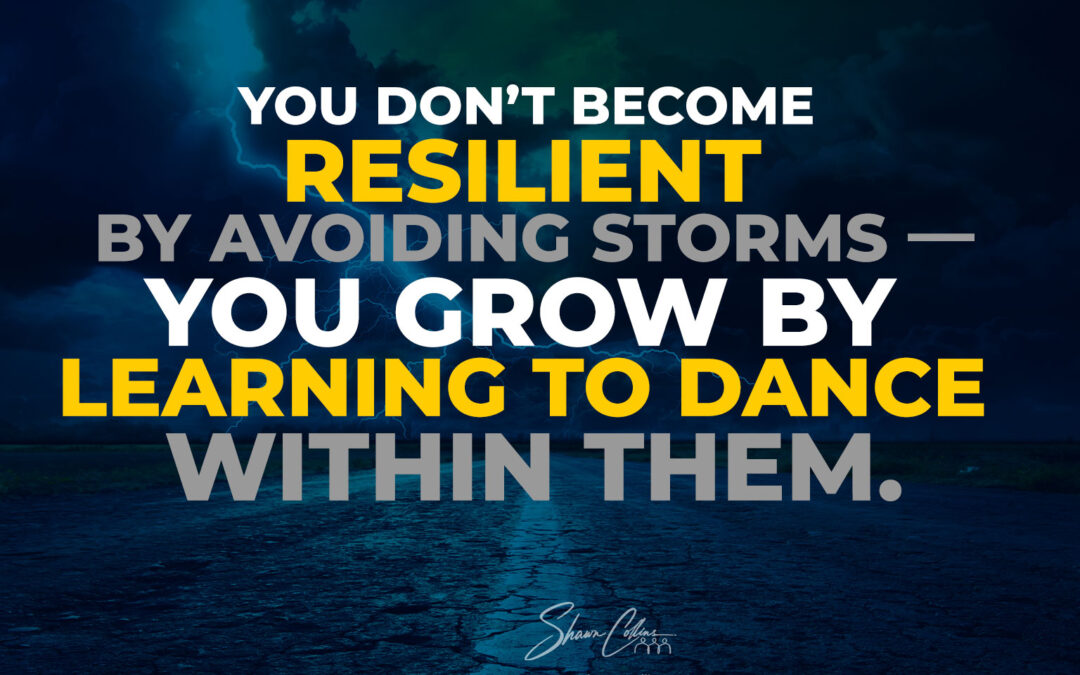If you’re in a leadership seat right now—running a company, scaling a startup, managing people across multiple time zones—you already know that adversity doesn’t wait for your convenience. Challenges show up uninvited. They cut through ambitious goals, tight plans, and even tighter margins. The leaders who survive that? They don’t dodge the storms. They step into them—strategically, mentally, and emotionally prepared to lead while navigating chaos.
Resilience isn’t a shield. It’s a practiced skillset. And it’s not about always being strong or composed. It’s about knowing how to recalibrate under pressure without losing your grip on the long game—whether that means guiding a company through economic upheaval or managing burnout in your team after another round of layoffs.
For C-suite executives, entrepreneurs, and people managers, resilience isn’t optional anymore. It’s where leadership starts and sustains itself. Plans won’t protect you from volatility. Metrics won’t motivate people through crises. What will? The gritty, functional kind of resilience that shows up in your decision-making, your modeling, and even in how you show up on a hard Monday when everything’s on fire.
2025 won’t slow down for you. You either build the capacity to lead through instability—or get buried by it.
In this piece, we’re cutting past the generic advice and diving into what it really takes to be resilient while leading. We’ll unpack how to weather storms, yes—but more importantly, how to move through them with focus, adaptability, and influence. Welcome to your real resilience playbook.
Understanding the Challenges Faced by Our Audience
Let’s get specific about what these “storms” actually look like. If you’re in any leadership role today—whether you’re occupying the corner office, bootstrapping your business, or managing a cross-functional team—you’re walking directly into turbulence every week.
This isn’t a theoretical struggle. It’s lived reality.
Economic instability doesn’t send a calendar invite.
A single market dip can derail product roadmaps, growth plans, and investor confidence. Inflation, rising interest rates, and shifting labor costs don’t just hit balance sheets—they test whether your leadership is grounded in adaptability or just optimism.
Cash flow gets tight. Talent gets nervous. Decisions get heavier.
Disruption is the default setting
Your closest competitor isn’t other companies right now. It’s change itself. AI, regulatory overhauls, supply chain breakdowns—all of it comes fast, unapologetic, and wildly unpredictable. The idea that you’ll ever have “full control” is a myth. What you can control is how you respond when control slips away.
The people stuff is harder than the technical stuff
Conflict between departments. Burnout across teams. A top performer who’s checked out and won’t say why. Remote dynamics that undermine communication and trust. Emotional labor is real, and whether you like it or not, you’re the container for it.
If you’re leading people, you’re leading emotion under pressure.
Technology outpaces strategy
Every platform, process, and piece of infrastructure seems “up for reinvention” every six months. That’s not always bad—but it means you’re constantly weighing tradeoffs between what’s scalable, secure, and actually usable. Being decisive while half the context changes around you? That’s a mental marathon every quarter.
And let’s talk about the human cost
Resilience isn’t just about leading others through storms—it’s about surviving them yourself. When a co-founder walks out, or you miss three weeks of sleep closing a round, or you’re quietly grieving behind the mask of management—it gets personal, fast.
Resilience gets tested in the private moments leadership doesn’t prepare you for.
The pressure to hold it all together
Here’s the kicker: you’re still expected to be calm, motivational, and clear-headed while it all spins. Your team looks to you as the constant. Investors want the confidence. Clients don’t care how tired you are. Everyone expects vision and execution—even when your bandwidth is wrecked.
This is the weight that breaks leaders who don’t build the muscle for it. But when you understand what you’re up against—and accept that storms don’t disqualify you, they define you—that’s where resilience starts to get real.
This isn’t about avoiding hard seasons. It’s learning how to pace yourself through them—without burning out, flipping tables, or losing your sense of direction.
The Psychology of Resilience: Why Avoidance Isn’t the Answer
When leadership turns into triage mode—and it will—your instinct might be to sidestep the chaos, hold your breath through the crisis, and hope it passes fast. That’s not resilience. That’s avoidance wearing a leadership badge. And it doesn’t work—not for long.
Resilience psychology isn’t about staying calm at all costs—it’s about knowing how to react when your plans blow up.
That starts in your mindset, not your org chart. Let’s talk about how your brain responds under pressure, and what the research says about leading wisely when you’re under strain.
Growth Mindset: Resilience is Learned, Not Assigned
The idea of a growth mindset isn’t just a leadership workshop buzzword—it’s the foundation of how resilient leaders think. Coined by psychologist Carol Dweck, the growth mindset revolves around believing that abilities can be developed through effort, strategy, and feedback.
Translation for leaders? You’re not “bad at navigating crises.” You might just be early in the reps.
Executives who adopt this mindset don’t measure their value by avoiding failure. They look at breakdowns, flaws, and uncertainty as normal parts of the process. They face hard feedback head-on. They question their own defaults. They stay curious under pressure instead of shutting down.
Resilience isn’t built through perfection. It’s built through deliberate recovery—learning how to fall, assess, adjust, and keep going without internalizing the storm as personal failure.
Emotional Agility: Feel It, Don’t Fake It
Emotional intelligence gets a lot of airtime, but what you actually want is emotional agility.
Coined by Dr. Susan David, emotional agility is the ability to recognize your emotions, accept them without letting them drive the bus, and take values-aligned action in the face of discomfort. It’s not “positive vibes only.” It’s being honest about your inner reality without being hijacked by it.
If you can’t name your frustration, you’ll misplace it. Probably on your team. Maybe on strategy. Either way, it leaks.
Resilient leaders aren’t emotionless. They just don’t let temporary emotions reroute long-term priorities. Emotional agility means you can feel disappointment, disorientation, or dread on a Tuesday morning—and still walk into high-stakes decisions with clarity because you know how to separate what’s real from what’s reactive.
Adaptability: Survival Isn’t Strategy, It’s Capacity
Having a great plan doesn’t matter if you freeze the moment things don’t go accordingly. Adaptability is your operational resilience—it’s what keeps you moving when the map is outdated.
Research on high-performing executives shows that adaptability consistently ranks high in successful leadership behavior, especially in volatile conditions. That’s because adaptable leaders don’t tie their identity to a single approach. They shift gears early and often without viewing it as surrender.
When adaptability is high, panic stays low.
Building muscle here means resisting the urge to lock into survival mode or force-fit yesterday’s strategy into today’s problem. It also means paying attention—noticing trend shifts, behavioral signals, or lagging team morale while there’s still time to adjust instead of react.
Avoidance Is a Short-Term Relief With Long-Term Costs
That meeting you bump, hoping the problem will solve itself? That forecast you ignore because it’s uncomfortable? That team conflict you leave untouched? It all adds up.
Avoidance creates debt. Emotional, cultural, strategic, and eventually financial.
It doesn’t mean you must tackle every challenge instantly or emotionally process in real time. But resilient leaders stay in the relationship with the discomfort. They don’t ghost the storm. They study it.
When you disconnect from tough tensions—internal or external—you rob yourself of the raw material for growth. The insights. The recalibrations. The opportunity to build trust by facing things fully and modeling calm presence on the other side.
That’s where the real influence lives. Not in flinching from hard things, but in holding steady while you navigate through them—eyes open, signals clear, mind intact.
Leadership isn’t about storm avoidance; it’s about storm fluency. Get fluent.
Strategies to ‘Dance Within the Storms’
You don’t learn to lead in calm seasons—you sharpen your edge inside the chaos. Resilience doesn’t just “show up” when things get hard. You build it with habits and decisions that hold up under pressure.
Here’s how real leaders build the muscle to move through the storm instead of bracing for impact:
Embrace Vulnerability Without Surrendering Authority
This isn’t just about being open. It’s about being honest while staying anchored. Admitting you’re navigating uncertainty doesn’t undercut your credibility—it actually builds it, when paired with presence and direction.
The real mistake? Pretending you’re fine when it’s obvious you’re not. Your team can feel the tension even if you don’t say it. When you acknowledge reality and still cast a path forward, you give them a reason to trust you—not just follow your authority.
Here’s what it looks like in practice: In Q2 of last year, a regional CEO at a logistics firm addressed his team directly after a critical contract fell through: “We’re not where we planned. I feel that too. But we have options, I’ve reviewed the pivots, and we’re not standing still.” That brief moment of grounded vulnerability? It kept half his top talent from quietly job-hunting that week.
Develop Emotional Intelligence as a Daily Leadership Skill
You don’t need to be a therapist—but you damn well better understand what emotional tone you’re setting and absorbing in your ecosystem.
Start by calibrating yourself. If you’re tense, cut off, or distracted, it spreads. EQ isn’t performative empathy—it’s the discipline of being aware of your impact in real time, especially under pressure.
Try this: Before your next leadership meeting, pause for 90 seconds to identify what you’re bringing into the room emotionally. It sounds elementary, but naming it before it leaks into your decisions is the difference between calm leadership and reactive command-and-control behavior.
Cultivate Mindfulness in a Way That Actually Works for You
Mindfulness isn’t about meditation pillows and calendar blocks labeled “Breathe.” It’s about clearing enough cognitive noise to see what matters when everything feels urgent.
Pick something that fits your operating style. That could be:
- Walking between meetings with no phone to reset your focus
- Pausing before you answer an email that makes you sweat
- Using a 3-minute audio prompt at the start of your week to ground your attention
One founder I advise starts Monday mornings by writing, “What do I actually control this week?” on a sticky note. Simple, repeatable, zero fluff—and mentally clears the fog every time.
Build a Support Network That Doesn’t Require Context Every Time
The right support system isn’t just people who cheer you on. It’s people who know your context, can challenge your blind spots, and don’t need a 15-minute prologue every time you drop into crisis-mode.
If you’re the smartest or most experienced person in every room, you’re under-supported.
Curate a personal board of advisors. Might be other founders, COO friends, old mentors, or fellow execs. They don’t have to be formally involved, but they do need to get the weight you carry and be willing to give it to you straight.
One CTO I know has a monthly check-in with two former colleagues—no agenda, just mutual processing and pattern-spotting. Low friction. High value. When his platform went down in December, one of them spotted the comms blindspot he was too fried to notice. Saved him a PR crisis.
Reframe the Challenge Instead of Resenting It
Hard doesn’t mean wrong. Challenge doesn’t automatically mean failure.
Resilient leaders redefine setbacks in real-time. Not with toxic positivity—but with forward-facing analysis.
Ask: What is this tension telling us? What assumption just got tested? What capacity is being built in this stress?
Example: When a SaaS startup hit a surprise churn spike, the instinct was panic. But their COO reframed it: “This is overdue feedback on product-market fit—let’s treat it as a free audit.” That mindset shift turned a potential boardroom blowup into a re-prioritization sprint that improved retention inside of two months.
Ritualize Recalibration
When the hits keep coming, you don’t rise to the occasion—you fall to your baselines. Which means you’d better make recalibration a leadership rhythm, not a recovery tactic.
Build these into your calendar:
- Weekly 20-minute gut-check with yourself: What’s draining you? What’s fueling you?
- Monthly “stress audit” with a peer: What patterns are showing up under pressure?
- Quarterly sprint retros not just for projects, but for how the leadership stressors were handled
Resilience is pattern awareness on repeat. If you’re not tracking how you lead under stress, you’ll repeat the reactions that create more fires down the line.
Bottom line: You can’t eliminate uncertainty, but you can lead inside it—well
This isn’t hype. It’s practice. And it pays off when you’re in a negotiation at month’s end with cash flow bleeding, or when your COO gives notice right after funding closes, or when your team is looking to you not just for decisions—but for emotional tone.
We’re not here to avoid storms. We train so we can dance through them—and still lead the room.
Leadership and Team Resilience: Creating a Culture That Thrives in Adversity
You can practice personal resilience in isolation, but if the rest of your team is unraveling, your organization won’t hold. Resilient leadership isn’t just about how you handle stress—it’s about how well you model and embed adaptive habits across the people who rely on you. Your calm isn’t worth much if no one else can find theirs.
Culture is built in micro-behaviors—but gets tested during storms.
So the question becomes: Are you building a culture that breaks under pressure, or one that bends and recalibrates? Here’s how to lead your team through the hard parts, while making resilience a shared operating system—not a solo performance.
Communicate with Context, Not Just Updates
Your team doesn’t just need timelines and KPIs. They need signal clarity when most inputs are noise.
What’s changing, why it matters, how it impacts them personally—and how their effort fits into the bigger picture. That’s the play.
Too often, leaders communicate like dispatchers instead of meaning-makers. When things start shaking, you need to step up context delivery. Explain decisions. Share constraints. Acknowledge tensions. Avoid the impulse to control through silence.
In crisis, over-communicating with empathy and relevance earns trust faster than polished statements ever will.
Empower Your Team Before They “Earn” It
Here’s the leadership trap: waiting until someone has “proved themselves” to trust their judgment. But resilience isn’t built through control—it’s built through distributed power.
High-trust orgs bounce back faster because decisions don’t bottleneck. People feel ownership. They see their role as part of navigating uncertainty, not just surviving it from below.
Try this litmus test: If a manager on your team had to make a $50K decision without you in a crisis, would they know how to move? If the answer’s no, you’re not just under-delegating—you’re underdeveloping.
Build Flexibility Into How—and Where—You Work
Rigid systems collapse faster. The strongest teams aren’t the ones that follow protocol—they’re the ones that adapt coherently while standards still hold. Don’t confuse structure with resilience.
Start mapping out real flexibility:
- Can delivery methods shift mid-project without chaos?
- Do team members have agency in how they structure their time under pressure?
- Is failure during recalibration framed as learning… or liability?
A CEO I work with uses the term “structured improvisation” when onboarding new team members. They’re trained under clear priorities and taught to self-adjust when the playbook is no longer useful. That mindset got them through three product pivots in one year without losing directional integrity.
Normalize Recovery as Part of Performance
If your team thinks resilience means “produce output at all costs,” congrats—you’re quietly building burnout instead of strength.
Real resilience accounts for recovery.
Leaders who walk the talk normalize breaks without guilt, encourage PTO without back-channeling, and celebrate recalibration—even when it slows short-term velocity.
Make space for team members to speak openly when they’re at a strain point. And when someone flags fatigue? Believe them the first time. You’ll get more energy in return from a three-day reset than six weeks of dragging performance and resentment.
Treat Learning as a Standing Operating Principle
In resilient cultures, teams don’t just execute tasks—they digest experience.
Every project, sprint, or setback is rich with data. But only if you actually stop long enough to reflect.
Start by asking better questions:
- What blind spots got exposed this quarter?
- Where did we over-index on speed instead of alignment?
- What behaviors helped us recover fastest?
Turn these debriefs into recurring, visible habits—and invite all voices into the analysis. When people feel safe to surface mistakes or tension without consequences, learning accelerates. So does resilience.
Demonstrate What Leadership Looks Like Under Pressure
The fastest way to build a resilient culture? Show them how it looks, up close.
When the stakes jump and the pressure peaks, your tone, actions, and steadiness speak louder than any all-hands meeting ever will.
Stay transparent instead of reactive. Stay responsive instead of controlling. And when you do misstep (and you will)—own it, correct it, and move forward. That’s the culture-defining leadership people remember and model themselves after.
You can’t outsource team resilience. You have to embody it first.
The habits you demonstrate under stress become the unspoken rules of engagement for everyone watching. Make those rules worth following.
Measuring and Sustaining Resilience Over Time
You don’t just build resilience once and call it a day. You track it. You test it. You tear it down and reinforce it as conditions shift. Because what worked for you or your team last year might not hold up in the next round of pressure. The strongest leaders aren’t assuming resilience—they’re measuring it and maintaining it like any core capability.
Without measurement, resilience becomes a buzzword. With it, it becomes a culture you can rely on.
Start With Self-Assessments That Go Beyond “I’m Fine”
If you’re checking in with yourself and the answer’s always “good” or “busy”…you’re not checking in. Self-assessment doesn’t need to be complicated—it just needs to be honest and consistent.
Try questions like:
- Where am I reacting instead of responding?
- What patterns keep surfacing under pressure?
- Am I restoring energy weekly—or just spending it?
- Have I created buffers or am I running on burnout?
Your insight starts with your patterns, not your calendar.
A CFO I coach uses a simple scorecard every Friday: Energy (1–10), Clarity (1–10), Influence (1–10). When those numbers dip consistently, he doesn’t push harder—he tunes back in. That rhythm has kept him stable through two major restructures without sidelining himself.
Build Real-Time Feedback Loops—Not Annual Performance Reviews
Waiting until the end of the quarter or year to evaluate resilience is too late.
You need signals in real time.
- Pulse surveys that ask two questions—“What’s pulling us forward?” and “What’s dragging us down?” can spot early stress symptoms.
- 1:1 check-ins that measure how someone is operating—not just what they’re producing—give you actual leadership data.
- Slack channels dedicated to surfacing win/loss lessons in the moment create a culture of adaptive learning, not passive waiting.
One startup VP created a weekly ritual called “Friday Fail Signals”—team drops one moment that tested them, and insight from it. Zero blame. High learning density. That’s continuous resilience in motion.
Use Performance Indicators That Actually Tell the Truth
If your only dashboard metrics are lagging indicators—like revenue, churn, or project completion—you’re too late to spot resilience gaps. Add indicators that reveal whether your team can endure strain while staying cohesive.
Watch for:
- Voluntary turnover in high-stress quarters—not just exits, but why they left.
- Decision velocity under uncertainty—are decisions getting stuck or moving with clarity?
- Manager escalation frequency—are pressure points being handled at the right levels or bubbling up constantly?
- Recovery time after disruption—how long does it take your team to get back to direction and focus?
Measure the bounce-back. That’s where your resilience ROI lives.
Institute Regular Reflection Cycles for the Leadership Team
You can’t sustain what you don’t revisit. Schedule cadence-based check-ins that look inward instead of outward.
Try this rhythm:
- Monthly leadership huddle: 15 minutes on personal stressors, 15 on team signals. No agenda other than truth.
- Quarterly offsite: Journal reflection on key leadership question—“Where did I hold steady, where did I slip?” Share slices in small groups.
- Annual recalibration: Align org’s resilience strategy with evolving business context. What habits stay, what breaks, what builds next?
One CEO I consult starts every exec offsite with a gut check: “What did this pressure-cooker year teach you about yourself as a leader?” The answers shape how each leader sets strategy—not just tasks, but tone.
Don’t Just Sustain—Build for the Next Level
Resilience isn’t a trophy. It’s a living capacity. It needs upgrades as the stakes rise. When things finally “calm down”—that’s your cue to push the edge, not coast.
Here’s how leaders I work with sustain momentum without burning out:
- Rotate challenges among execs to build range, not just specialization
- Design stretch roles that require emotional and strategic endurance
- Invest in coaching or peer groups for reflective leadership—not just tactical advice
If you wait for calm to rebuild, you’ll miss your window.
Resilience isn’t static. It’s a tested, evolving capacity. Track it like it matters—because in leadership, it does.
You can’t lead what you don’t measure. So don’t leave resilience to chance or vibes. Get specific. Stay accountable. And keep stretching into the next version of leadership your team will need tomorrow.
Conclusion: Embracing the Storm to Unlock Growth and Opportunity
Resilience doesn’t mean waiting for the clouds to clear. It means learning how to lead, build, and thrive while the wind is howling.
You’ve got the data now. The playbook. The real talk on what it takes to lead through pressure and come out sharper, not just intact.
Here’s what should be clear by now:
- Storms aren’t interruptions to your leadership. They’re the training ground.
- Resilience isn’t personality—it’s practice. Built in reps. Maintained in rhythms.
- Avoidance delays growth. Engagement triggers it.
- Teams don’t become resilient accidentally. They mirror what you model.
- You don’t need heroic stamina. You need consistent recalibration.
Every challenge you’re avoiding holds a piece of your next level.
So whether you’re watching Q2 forecasts get shaky, navigating a high-stakes team transition, or just dog-tired from six months of relentless plate-spinning—don’t sit it out. Don’t shrink your scope. Step into the chaos like it’s familiar terrain, because now it is.
If you’re waiting for ease before you commit to your next evolution as a leader, you’ll wait forever. The signal isn’t silence. The signal is the storm.
This year, don’t brace. Don’t flinch. Don’t default to survival. Dance.
Build the version of resilience that leads when things break, recalibrates fast, and makes decisions that people want to follow. Make that your standard.
Because if you’re reading this, you’re in the arena already—and it’s time to lead like it.




